
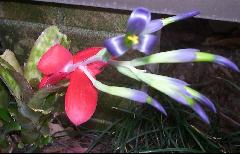
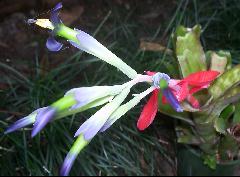
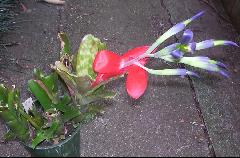
The plant shown below, originally labelled 'amoena nana' and probably sourced form Bill Morris, has been re-labelled as 'Windigig Special'.
See also article DD 10/13: Billbergia Windigig Special and comparison with B. buchholtzii No. 1 and with B. nana


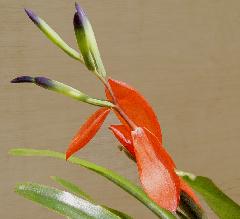
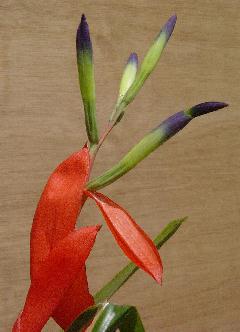
| Ian Hook, Sydney 11/03. |
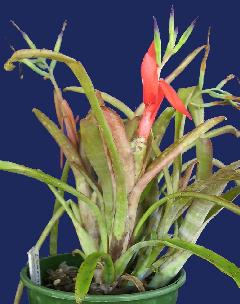

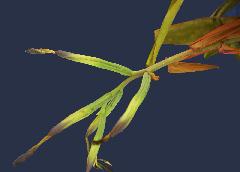
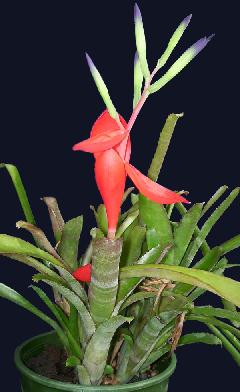
Billbergia nana E. Pereira Bradea 1: 316-8 1973
translated from the Latin and Portuguese by Butcher.
Plant very short stoloniferous, ca 22cm high, leaves ca 12, rosulate, forming a cylindrical utriculum.
Leaves ligulate, ca 20-25cm long, ALL PURPLISH, the outside totally white lepidote.
Sheath oblong, 10cm long, 4cm wide, with hyaline edges, both sides inconspicuously lepidote.
Blades linear, 10cm long, 2-4cm wide, the tip rounded and emarginate, with a mucron added, besides being rolled back from the edge, spines sparse and minute on the edges, both sides white lepidote.
Scape erect, 19cm long, 5mm thick, white, glabrous, the lower internodes 4cm long, the upper ones 2cm long,
Scape bracts oblong-lanceolate, purple, glabrous, ca 6cm long, 25m wide, tip acute and mucronulate, the lower ones appressed, internodes hidden in the erect sheaths, the upper ones ca 4-5, free, reflexed, internodes visible.
Inflorescence simple, ca 5 flowered, erect, 8cm long, exceeding the leaves.
Rhachis green, glabrous.
Floral bracts minute, scale-like, becoming acute.
Flowers 5-6cm long, sessile.
Sepals free, linear spatulate, 25mm long, glabrous, tip obtuse, the upper half violet, the lower green.
Petals linear-spathulate, the base with 2 fimbriate ligules, and in addition 2 longitudinal calluses, up to 4cm long, the limb violet the remainder pale green, erect before anthesis.
Stamens shorter than the petals, Filaments cylindrical, green, series II highly connate with the petals, Anthers linear, 5mm long, yellow, the tip rounded and very minutely mucronate, the base rounded and emarginate, dorsifixed below the middle, Pollen grains ellipsoid with one fissure, Style 45mm long, cylindric, green, exceeding the stamen.
Ovary cylindric, ca 15mm long, sulcate, green and glabrous, epigynous tube almost missing, Placentae linear affixed to the middle of the loculi, ovules numerous, obtuse.
Habitat Brazil, Espirito Santo, Pedro Azul, Leg Alvin Seidel no. 642, 8 Dec. 1972 Holotype HB no. 52.248
This species has some affinity with B. amoena (Lodd) Lindl. but from this and its known varieties it is distinguished by the clearly simple inflorescence with very few flowers, by the very small size of the plant with entirely purplish leaves.
Being collected in Espirito Santo and cultivated in Santa Catarina, it is possible that this plant represents only another variety of B. amoena, but considering the discrepancies our plant presents, both from the typical form of B. amoena and from its known varieties, and for the lack of knowledge about the variability of this species, we prefer to consider it as separate species in order not to increase the confusion already existing in the B. amoena complex. It is true that the Bromeliads, specially the Billbergias, Vrieseas and Neoregelias are subject to great ecological variations, due to the great capacity of adaptation and facility in hybridizing. In this case however the discrepancies are in my opinion too great.”